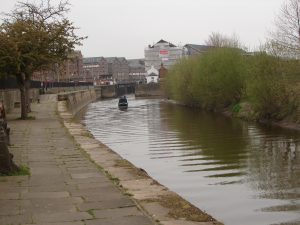 The River Severn is an important geographic feature of the towns and villages where all but three of the Lady Apollonia West Country Mysteries are set, and in one of the settings away from the river, it still plays a role in the story. The Severn is the one of the longest rivers in England, second only to the Thames, and it is tidal. I have written about its famous tidal phenomenon called the Severn Bore in my previous posting. Although not the precise political border between England and Wales, the Severn River is key to the separation of the history and economy of the peoples of both countries.
The River Severn is an important geographic feature of the towns and villages where all but three of the Lady Apollonia West Country Mysteries are set, and in one of the settings away from the river, it still plays a role in the story. The Severn is the one of the longest rivers in England, second only to the Thames, and it is tidal. I have written about its famous tidal phenomenon called the Severn Bore in my previous posting. Although not the precise political border between England and Wales, the Severn River is key to the separation of the history and economy of the peoples of both countries.
The picture on the left shows the river in Gloucester, setting of my third novel, Memento Mori, in the Lady Apollonia West Country mysteries. It is taken looking south from the medieval quay, an important location in the story. The buildings in the background are modern, only going back to the 19th century. My most recent book, King Richard’s Sword, is set in Worcester, further upriver than Gloucester where some of my characters in the story live on the far side the Severn from the medieval city.
Aust, the home village of Lady Apollonia, occupies an important location on the estuary of the Severn. It is at the narrowest place of the estuary as one approaches from the Bristol Channel and is only a mile wide at Aust, widening as one goes upstream. Since the time of the Romans, people have used Aust, the village named for the Latin prefix meaning south, as the southern-most place to cross from England into Wales and back again. A regular ferry service operated at Aust throughout the middle ages and down through the centuries until 1966 when it was replaced by a motorway bridge. The medieval ferry plays an important role in Effigy of the Cloven Hoof, the first novel in my series. In the 19th century, this area was chosen for a railway tunnel connecting England with Wales, again because it is the narrowest crossing point between the two countries.
Joseph of Arimathea’s Treasure, the fifth of the Lady Apollonia novels, opens with two Druids from Ireland getting off the ferry at Aust and then walking upriver some distance to throw a gift into the Severn in thanks for their safe crossing. This was an expression of their Celtic reverence for the river. The Welsh name for the river was Habren while the Romans called it Sabrina. The English name of Severn may be a corruption of these.
For more information on the legends and naming of the river, click on
http://www.whitedragon.org.uk/articles/sabrina.htm .
For more information on the Aust Ferry, click on
https://en.wikipedia.org/wiki/Aust_Ferry .
Tags: Chaucer's England, historical fiction, medieval mysteries